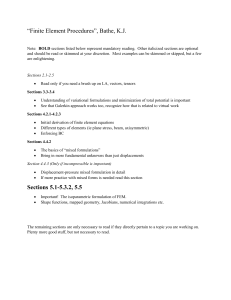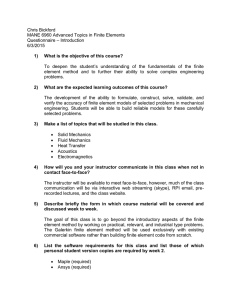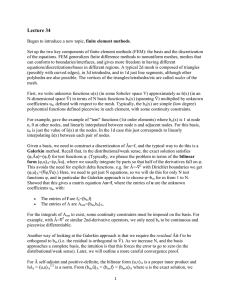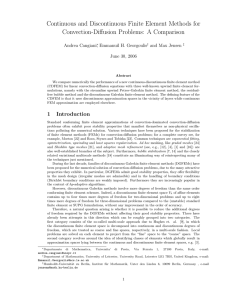Thomas Provencher 6/1/2015
advertisement
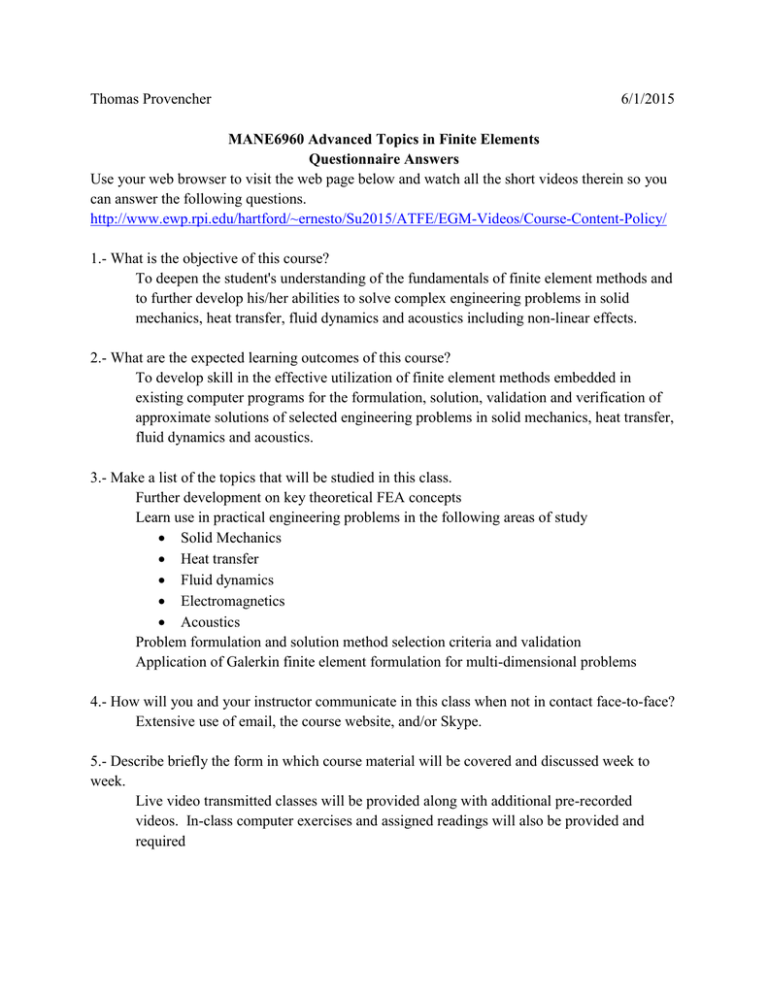
Thomas Provencher 6/1/2015 MANE6960 Advanced Topics in Finite Elements Questionnaire Answers Use your web browser to visit the web page below and watch all the short videos therein so you can answer the following questions. http://www.ewp.rpi.edu/hartford/~ernesto/Su2015/ATFE/EGM-Videos/Course-Content-Policy/ 1.- What is the objective of this course? To deepen the student's understanding of the fundamentals of finite element methods and to further develop his/her abilities to solve complex engineering problems in solid mechanics, heat transfer, fluid dynamics and acoustics including non-linear effects. 2.- What are the expected learning outcomes of this course? To develop skill in the effective utilization of finite element methods embedded in existing computer programs for the formulation, solution, validation and verification of approximate solutions of selected engineering problems in solid mechanics, heat transfer, fluid dynamics and acoustics. 3.- Make a list of the topics that will be studied in this class. Further development on key theoretical FEA concepts Learn use in practical engineering problems in the following areas of study Solid Mechanics Heat transfer Fluid dynamics Electromagnetics Acoustics Problem formulation and solution method selection criteria and validation Application of Galerkin finite element formulation for multi-dimensional problems 4.- How will you and your instructor communicate in this class when not in contact face-to-face? Extensive use of email, the course website, and/or Skype. 5.- Describe briefly the form in which course material will be covered and discussed week to week. Live video transmitted classes will be provided along with additional pre-recorded videos. In-class computer exercises and assigned readings will also be provided and required 6.- List the software requirements for this class and list those of which personal student version copies are required by week 2. Maple (required) ANSYS (required) MATLAB (optional) ABAQUS (optional) 7.- Describe the expected contents and formats of the student’s web portfolios. Class assignments and homework must be stored on the website. PDF files are preferred but native MAPLE, MATLAB, COMSOL, ANSYS log files, and ABACUS inp files are acceptable. 8.- Describe the type and frequency of submission of the required deliverables (homework assignments) in this class. Weekly deliverables will be assigned and at the very least the computer model and initial results must be provided. A final report with data supporting the results of the computer model will be required for each deliverable. 9.- List the three types of reading assignments for this class and list the texts that will be used. Selected textbook sections Selected technical papers/reports on individual class topics Selected sections of software manuals 10.- Describe how will the student’s performance in this class be graded. 10 points are available for each modeling exercise. 90 pts will provide an A and 75 points a B. 11.- Write down and bookmark in your own personal computer the URL for the course webpage. Also add me to your contact list in Skype. My ID is ernesto.pedro.gutierrez.miravete. Done 12.- Set up your RPI web portfolio page with a link to this class. Please contact me if you need any assistance. Done 13.- Navigate through and examine all the links in the class web page. Done 14.- Watch the posted video on the Galerkin Finite Element Method (http://mediasite.itops.rpi.edu/Mediasite5/Play/4d49d8af7771431b864559b33854da1a1d) Write one sentence describing each step involved in the implementation of the method. 1. Variation (weak) form Introduce “test” function and integrate it multiplied by double derivative of “u” using integration by parts. Set this equal to the integral of the multiple of the test and forcing funtions. 2. Finite element mesh and basis functions Subdivide the domain into contiguous sections and use linear interpolation to establish the basis functions. 3. Galerkin’s method Represent the approximation to the problem as a linear combination of global finite element basis functions and express the test function used to obtain the variational formulation as an identity combination with the basis function 4. Solve system of algebraic equations Place coefficients of the equations created by the Galerkin’s method into a square matrix and an array and solve for the unknown “u” values 5. Quality of the approximate Solution Evaluate difference between the exact solution and the Galerkin’s approximation and plot if possible or evaluate the “energy of the error.” 15.- Read through Chapters 1 and 3 in Text Z-I (See Links link). Done
